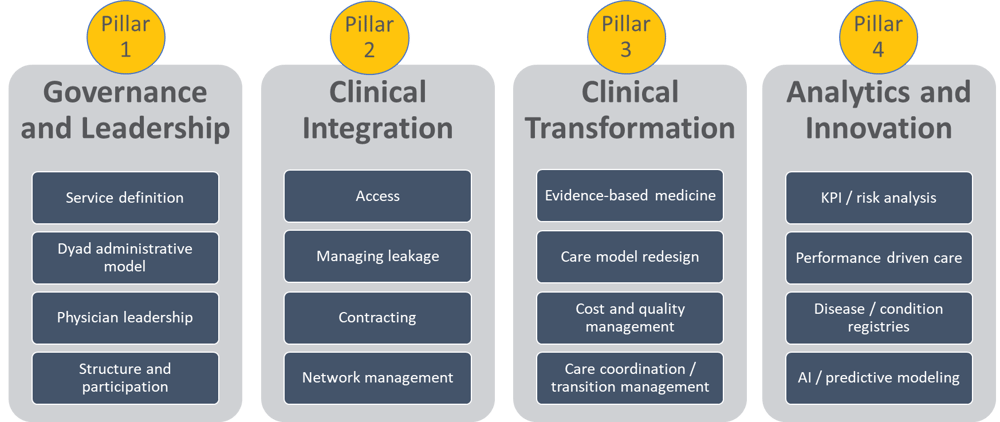Hospitals and health systems across the country are reexamining their clinical service line strategies and operations in response to the shift from volume to value. In addition to population-based and episode-based payment reforms initiated by public and private payers, providers are challenged by mergers and acquisitions, clinical integration, consumerism and price transparency. Strengthening clinical service line strategies and capabilities are critical approaches to addressing these many challenges.
This post is the third in a four-part series where we introduce the pillars of success for clinical service lines: Governance and Leadership, Clinical Integration, Clinical Transformation, and Analytics and Innovation.
The Four Pillars of Clinical Service Line Success

In this post, we address pillar three: Clinical Transformation.
Evidence-Based Medicine
Service line management is a useful tool for health systems all over the country to improve care while reducing costs. Effective service line organizations use evidence-based medicine to create metrics, access solutions, and develop care pathways that reduce unwanted variations in care and improve patients’ experiences and outcomes. Service line leaders and participants must have an ongoing understanding of cost and revenue as well as quality and outcomes to achieve patient, physician, and institutional goals.
Standardized clinical protocols are key to strong performance in service line outcomes. The goal is to work smarter, not harder. Evidence-based clinical guidelines, order sets, and care pathways allow physicians and other providers to improve the quality of routine care while using resources more efficiently. Protocols and pathways are also key to managing patients as they move through an episode of care.
Protocol development should be led by episode-specific physician governance groups (see part one of this series), with participation from key stakeholders such as pharmacy, therapy, and other specialties as needed. These multidisciplinary teams should review and select existing protocols and research, develop, and implement new protocols that target impacted episodes.
Next, the service line team is ready to undertake the development and measurement of clinical pathways from diagnosis to treatments defined by evidence and outcomes. In a women’s health service line, for example, some of the early steps toward improving care and decreasing costs may include reducing hysterectomies, establishing integrated clinical programs for complex gynecological conditions, and creating a comprehensive service approach for reproductive medicine.
Care Model Redesign and Clinical Variation Reduction
As an organization tracks physician performance in the service line, it is very common to identify performance variations between the specialist physicians. As part of initial governance design, participating organizations must determine how they will use policies and processes to manage variation in physician performance.
No matter what specific processes are developed, it is important that these decisions be led and managed by physicians themselves.
The most effective way physicians can affect performance in service line outcomes is to change clinical practice patterns and utilize the most efficient sites of care. Therefore, they need analytics that show how these changes influence targeted measures and outcomes. This topic is covered in more detail in part four: Analytics and Innovation.
However, organizations should focus on common categories of clinical variation that can be improved through changes in clinical practice and physician behavior, including:
- Quality and clinical outcomes
- Clinical resource utilization
- Site of care efficiencies and costs
- Patient and provider satisfaction
- Precise clinical documentation
Improvements in each of these areas can result in significant expense reduction and quality improvement to achieve the service line integration goals.
Cost and Quality Management
Once evidence-based approaches and physician-led decisions are made regarding opportunities to transform care and reduce clinical variation, key performance indicators (KPIs) can be used to monitor progress.
Individual physician and team scorecards should be developed to track service line KPIs and individual physician performance and should be monitored by appropriate physician-led governance committees. Well-designed physician scorecards demonstrate expected behavior changes, and they illustrate the pathway to goal achievement through clinical integration. Physician scorecards also foster peer comparisons that promote transparency, friendly competition and improvement in process and care delivery.
Service lines must also make sure physician incentives are aligned with quality and outcome goals measured in the scorecards. Physicians need to understand not only the financial benefit, but also the benefit for patients, the community, and the organization. For most physicians, these benefits are just as important as personal rewards.
Do not forget to include formal and informal physician influencers in the incentive design process. These influencers are key to managing physician expectations and gaining support through involvement and transparency.
The common denominator of all the strategies described above is involvement. At all levels of decision-making for service line optimization, no problem is too small or too complicated to involve physicians. Doing so will demonstrate transparency and lead to increased trust and collegiality.
Care Coordination / Transition Management
Case management, care management, care coordination, and transitions of care and navigation are terms used to describe capabilities and functions critical to service line success. Although there are some differences in how health systems name these services and functions, they are all designed to reduce health risks and the cost of care by delivering the right care at the right time to the right patient at the right site of care.
Examples of care coordination and navigation challenges faced by service line leaders include lack of integrated processes across the continuum, resulting in suboptimal patient handoffs, limited use of risk stratification to define and manage populations, and limited visibility and measurement of the impact of care management on outcomes and key performance indicators.
To overcome these challenges, service line leaders need to improve processes and measures targeting medication reconciliation and functional status, measurements of handoff efficiency, community resource optimization, and social determinants of health screening.
The shift to value and requirements of clinical integration make care coordination and transition management even more important to service line outcomes. Successful outcomes in population health and episodes of care require managing patients throughout the full continuum of care, including primary, ambulatory, acute and post-acute care. It also requires that service lines take a team-based, patient-centered approach to treatment which is coordinated between and across sites of care. When care coordination and transition management are successful, service lines are better able to deliver higher quality, lower cost care and succeed in their value-based contracts.
In summary, clinical service lines prioritize clinical transformation as the third pillar of success in value-based contracting. This includes evidence-based medicine, care model redesign, cost and quality management, and care coordination and transition management. Each of these clinical process areas can help a service line effectively improve patient and physician experience and increase overall value to the organization.
Our fourth and final blog post in this four-part series will discuss the fourth pillar: Analytics and Innovation. This topic will include discussions on KPIs and risk analysis, performance-driven care, disease and condition registries, and artificial intelligence/predictive modeling.



Share this: